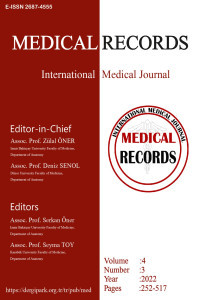Prediction of Short or Long Length of Stay COVID-19 by Machine Learning
Covid-19, machine learning, R programming, length of stay, accuracy, management
Prediction of Short or Long Length of Stay COVID-19 by Machine Learning
Covid-19, machine learning, R programming, length of stay, accuracy, management,
___
- 1. Akcan FA, Onec K, Annakkaya A, et al. Düzce University Hospital in the pandemic process: from the perspective of chief physician. Konuralp Medical Journal. 2020;12:354–7. 2. Costa GJ, Júnior H de AF, Malta FC, et al.
- 2. The impact of the COVID-19 pandemic on tertiary care cancer center: Analyzing administrative data. Semin Oncol. 2022;49:182– 8.
- 3. Abdollahi F, Ghanyan S, Asadi F. COVID-19 pandemic and management on hospital length of stay: A review. Healthcare in Low-Resource Settings. 2021;9:10057.
- 4. Scanlon C, Cheng R, McRobb E, Ibrahim M. In-house testing for COVID-19: effects on length of stay, isolation and the need for inpatient rehabilitation. Aust Health Review. 2022;46:273–8. 5. Alwafi H, Naser AY, Qanash S, et al.
- 5. Predictors of length of hospital stay, mortality, and outcomes among hospitalised covid-19 patients in Saudi Arabia: a cross-sectional study. J Multidiscip Healthc. 2021;14:839-52. 6. Javaid M, Haleem A, Pratap Singh R, et al. Significance of machine learning in healthcare: features, pillars and applications. International Journal of Intelligent Networks. 2022;3:58-73.
- 7. Vaishya R, Javaid M, Khan IH, Haleem A. Artificial Intelligence (AI) applications for COVID-19 pandemic. Diabetes Metab Syndr. 2020;14:337-9.
- 8. WHO European health information at your fingertips. https://gateway.euro.who.int/en/indicators/ hfa_540-6100-average-length-of-stay-all-hospitals/ visualizations/#id=19635&tab=table access date 04.05.2023.
- 9. Zayed NE, Bessar MA, Lutfy S. CO-RADS versus CT-SS scores in predicting severe COVID-19 patients: retrospective comparative study. Egypt J Bronchol. 2021;15:13.
- 10. The jamovi project. https://www.jamovi.org access date 25.12.2022 11. R: A Language and environment for statistical computing. https://cran.r-project.org access date 25.12.2022
- 12. A Short Introduction to the caret package. https://cran.rproject.org/web/packages/caret/vignettes/caret.html acces date 06.12.2022. 13. Kumar A. Pre-processing and modelling using caret package in R. International Journal of Computer Applications. 2018;181:39–42.
- 14. Al-Areqi F, Konyar MZ. Effectiveness evaluation of different feature extraction methods for classification of covid-19 from computed tomography images: A high accuracy classification study. Biomed Signal Process Control. 2022;76:103662.
- 15. Raschka S. Model evaluation, model selection, and algorithm selection in machine learning. ArXiv. 2020:/abs/1811.12808
- 16. Kuhn M. Building predictive models in R using the caret package. Journal of Statistical Software. 2008;28:1–26.
- 17. Bond RR, Novotny T, Andrsova I, et al. Automation bias in medicine: the influence of automated diagnoses on interpreter accuracy and uncertainty when reading electrocardiograms. J Electrocardiol. 2018;51:6–11.
- 18. Ranganathan P, Pramesh CS, Aggarwal R. Common pitfalls in statistical analysis: measures of agreement. Perspect Clin Res. 2017;8:187.
- 19. Grandini M, Bagli E, Visani G. Metrics for multi-class classification: an overview. ArXiv. 2020:/abs/2008.05756
- 20. Dalianis H. Evaluation Metrics and Evaluation. In: Dalianis H, editor. Clinical Text Mining: Secondary Use of Electronic Patient Records. Cham: Springer International Publishing; 2018. p. 45–53.
- 21. Alimohamadi Y, Yekta EM, Sepandi M, et al. Hospital length of stay for COVID-19 patients: a systematic review and meta-analysis. Multidiscip Respir Med. 2022;17:856.
- 22. Savrun A, Aydin IE, Savrun ST, Karaman U. The predictive role of biomarkers for mortality in COVID-19 patients. Trop Biomed. 2021;38:366–70.
- 23. Oksuz E, Malhan S, Gonen MS, et al. COVID-19 healthcare cost and length of hospital stay in Turkey: retrospective analysis from the first peak of the pandemic. Health Econ Rev. 2021;11:39.
- 24. Chamberlin JH, Aquino G, Schoepf UJ, et al. An interpretable chest CT deep learning algorithm for quantification of COVID-19 lung disease and prediction of inpatient morbidity and mortality. Acad Radiol. 2022;29:1178–88.
- 25. Purkayastha S, Xiao Y, Jiao Z, et al. Machine learning-based prediction of COVID-19 severity and progression to critical illness using CT imaging and clinical data. Korean J Radiol. 2021;22:1213–24.
- 26. Olivato M, Rossetti N, Gerevini AE, et al. Machine learning models for predicting short-long length of stay of COVID-19 patients. Procedia Comput Sci. 2022;207:1232–41.
- 27. Saadatmand S, Salimifard K, Mohammadi R, et al. Using machine learning in prediction of ICU admission, mortality, and length of stay in the early stage of admission of COVID-19 patients. Ann Oper Res. 2022;1-29.
- 28. Alabbad DA, Almuhaideb AM, Alsunaidi SJ, et al. Machine learning model for predicting the length of stay in the intensive care unit for COVID-19 patients in the eastern province of Saudi Arabia. Inform Med Unlocked. 2022;30:100937.
- Yayın Aralığı: Yılda 3 Sayı
- Başlangıç: 2019
- Yayıncı: Zülal ÖNER
Hasan Esat YÜCEL, Tufan ULCAY, Ozkan GORGULU, Kağan TUR, Muhammed Hüseyin KIRINDI, Elif ÇÖMLEKÇİ, Emre UĞUZ, Berat YAĞMUR, Burcu KAMAŞAK, Ahmet UZUN
Prediction of Short or Long Length of Stay COVID-19 by Machine Learning
Muhammet ÖZBİLEN, Zübeyir CEBECİ, Aydın KORKMAZ, Yasemin KAYA, Kaan ERBAKAN
The Relationship between Spondylolisthesis and Modic Changes: An MRI Study
Veysel DELEN, Alparslan YETİŞGİN, Serap SATIŞ, Safiye KAFADAR, Hamza ERDOĞDU, Saime SHERMATOVA
Can Cranium Size be Predicted from Orbit Dimensions?
Did the COVID-19 Pandemic Period Increased Suicide Attempts in Society?
Hüseyin ERDEM, Mustafa TEKELİ, Yiğit ÇEVİK, Nazire KILIÇ ŞAFAK, Ömer KAYA, Neslihan BOYAN, Özkan OĞUZ
Investigation of the Sox-9 and Caspase-6 Immune Activity in Placentas of Pregnant Women with GDM
Ece ÖCAL, Senem ALKAN AKALIN, Engin DEVECİ
Anıl ALTIPARMAK, Muhammed Furkan ARPACI, Merve AYDIN, Feyza İNCEOĞLU, Hıdır PEKMEZ
Invention Arising From Surgical Service Needs; Stoma Bag Cover
